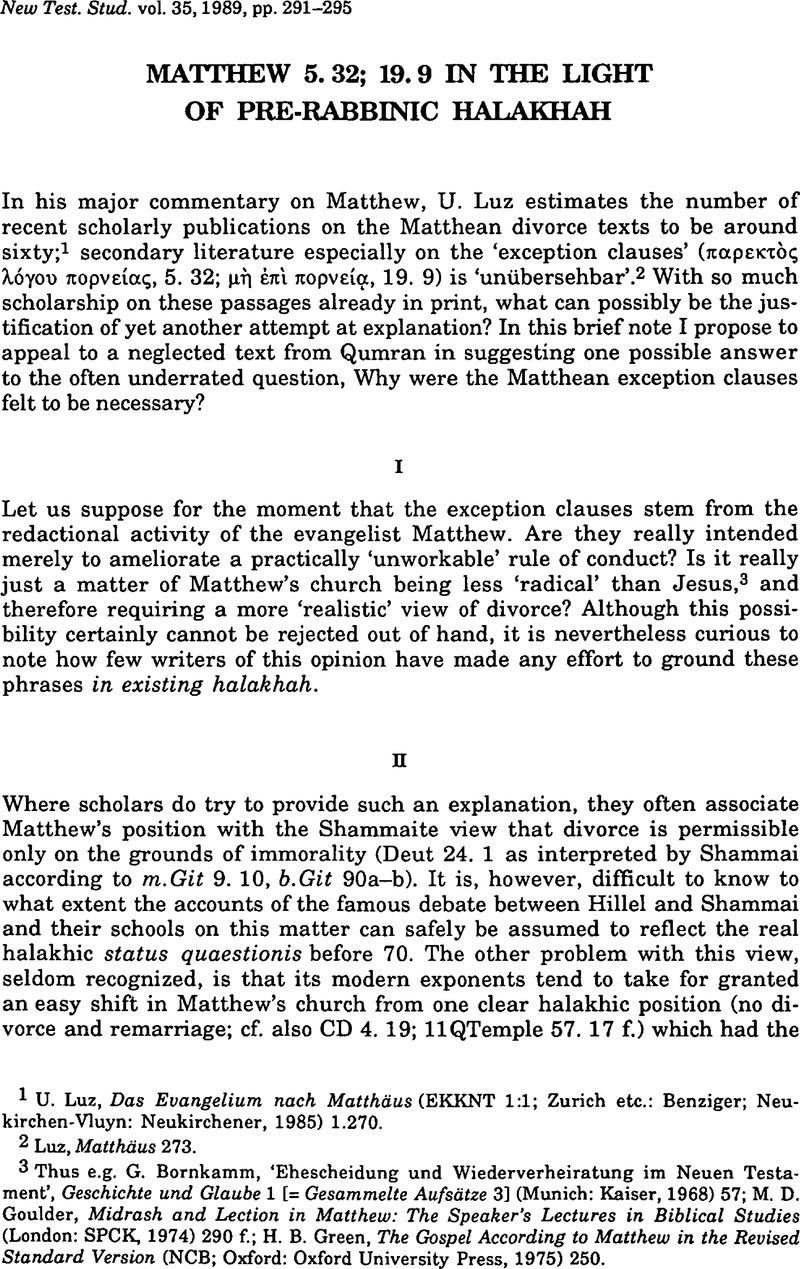Published online by Cambridge University Press: 05 February 2009

page 291 note 1 Luz, U., Das Evangelium nach Matthäus (EKKNT 1:1; Zurich etc.: Benziger; Neukirchen-Vluyn: Neukirchener, 1985) 1. 270.Google Scholar
page 291 note 2 Luz, , Matthäus 273.Google Scholar
page 291 note 3 Thus e.g. Bornkamm, G., ‘Ehescheidung und Wiederverheiratung im Neuen Testa-ment’, Geschichte und Glaube1 [= Gesammelte Aufsätze 3] (Munich: Kaiser, 1968) 57Google Scholar; Goulder, M. D., Midrash and Lection in Matthew: The Speaker's Lectures in Biblical Studies (London: SPCK, 1974) 290 f.Google Scholar; Green, H. B., The Gospel According to Matthew in the Revised Standard Version (NCB; Oxford: Oxford University Press, 1975) 250.Google Scholar
page 292 note 1 Cf. e.g. Luz, , Matthäus 275et al.Google Scholar; also esp. Nembach, U., ‘Ehescheidung nach AT and jüdischem Recht’, TZ 26 (1970) 164 ffGoogle Scholar. See already Abrahams, I., Studies in Pharisaism and the Gospels (London: Macmillan, 1917) 1.72–5.Google Scholar
page 292 note 2 E.g. m.Ned 11.12; cf. m.Sot 5.1; y.Sot 1.1 16b27; b.Sanh 41a; also Rashi, on Deut, 24. 1.Google Scholar
page 292 note 3 See esp. the Roman, Lex Julia de adulteriis of 18 B.C.Google Scholar: cf. e.g. Balsdon, J. P. V. D., Roman Women: Their History and Habits (London: Bodley Head, 1962) 218 f.Google Scholar, citing Corbett, P. E.; Crouzel, H., L'Eglise Primitive Face au Divorce: Du premier au cinquième siècle (Théologie Historique 13; Paris: Beauchesne, 1971) 38 f.Google Scholar
page 292 note 4 See Crouzel, , L'Église 47–51.Google ScholarLuz, , Matthäus 275 n. 47.Google Scholar
page 292 note 5 Tg. Neof. (gloss) and LXX: ‘defiles’ (![]() /μιαíνω); cf. Jer 3. 1.
/μιαíνω); cf. Jer 3. 1.
page 292 note 6 For this idea cf. e.g. Davies, W. D., The Territorial Dimension of Judaism (Berkeley etc.: University of California, 1982) 20 f.Google Scholar
page 293 note 1 Rosenthal, F., Review of Avigad, N. and Yadin, Y., A Genesis Apocryphon (Jerusalem: Magnes, 1956)Google Scholar, MES 18 (1959) 83.Google Scholar
page 293 note 2 Greenfield, J. C., ‘The Genesis Apocryphon – Observations on Some Words and Phrases’, Studies in Hebrew and Semitic Languages: Dedicated to the Memory of Prof. Eduard Yechezkel Kutscher (ed. Sarfatti, G. B. et al. ; Ramat-Gan: Bar-Ilan University, 1980) xxxv.Google Scholar
page 293 note 3 Pace Rosenthal 83.Google ScholarFinkelstein, L., ‘The Book of Jubilees and the Rabbinic Halaka’, HTR 16 (1923) 55 f.CrossRefGoogle Scholar, is miscited by Rosenthal and in fact supports the position advocated by Greenfield and the present writer: Jacob is not viewed as a priest.
page 293 note 4 Gen 35. 22 (a passage too offensive to be translated in the synagogue: m.Meg 4.10; see Tg. Ps.-J.); cf. Gen 49.4 and LXX [⋯μíανας]; 1 Chron 5.1.
page 294 note 1 Finkelstein, , ‘Jubilees’ 56 and n. 78Google Scholar further points out that this incident agrees with later Karaite halakhah, while in rabbinic discussion the principle was thought to apply only to royalty.
page 295 note 1 Thus most recently Fitzmyer, J. A., ‘he Matthean Divorce Texts and Some New Palestinian Evidence’, To Advance the Gospel: New Testament Essays (New York: Crossroad, 1981) 97.Google Scholar
page 295 note 2 So e.g. Green, , Matthew 84Google Scholar; Patte, D., The Gospel According to Matthew: A Structural Commentary on Matthew's Faith (Philadelphia: Fortress, 1987) 108 n. 27.Google Scholar
page 295 note 3 Cf. Luz, , Matthew 275.Google Scholar
page 295 note 4 Wenham, G. J., ‘Matthew and Divorce: An Old Crux Revisited’, JSNT 22 (1984) 98–100 and 102–5.Google Scholar respectively. Cf. further his ‘The Syntax of Matthew 19.9’, JSNT 28 (1986) 17–23.Google Scholar
page 295 note 5 The patristic trend against second marriages in general (even after the death of the spouse) is possibly a related matter. It is present in Origen, Tertullian and others (see e.g. Kötting, B., ‘Digamus’, RAC 3 [1957] 1020 f.Google Scholar), and may be implied, at least for church officers, in 1 Tim 3. 2, 12; 5. 9–12.(widows); Tit 1. 6. See Lev 21. 13–15.(but cf. Ezek 44. 22); for widows cf. perhaps Jdt 8.4 ff., 16. 22; Luke 2. 36 f.
page 295 note 6 I am grateful for comments on this paper received from Dr W. Horbury and Messrs P. Head and M. Thompson, all of Cambridge.